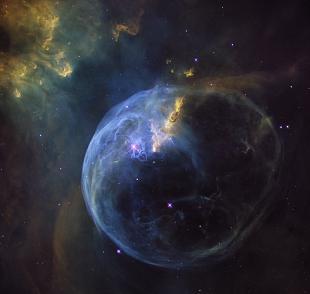NGC 7635
| Emission nebula | |
|---|---|
| NGC 7635 (Bubble Nebula)
|
|

|
|
| Section of the nebula with the bubble created by the stellar wind of BD + 60 ° 2522. False color image captured with the Hubble Space Telescope using line filters for oxygen (blue), hydrogen (green) and nitrogen (red). | |
| AladinLite | |
| Constellation | Cassiopeia |
|
Position equinox : J2000.0 , epoch : J2000.0 |
|
| Right ascension | 23 h 20 m 45.6 s |
| declination | + 61 ° 12 ′ 44 ″ |
| Appearance
|
|
| Apparent brightness (B-band) | 11.0 mag |
| Angular expansion | 15 ′ × 8 ′ |
| Ionizing source | |
| designation | BD + 60 ° 2522 |
| Type | O6.5 star |
| Physical data
|
|
| distance | 7100 ly |
|
history
|
|
| discovery | William Herschel |
| Date of discovery | November 3, 1787 |
| Catalog names | |
| NGC 7635 • GC 4947 • H IV 52 • h 2235 • LBN 549 • Sh2-162 | |
NGC 7635 also bubble mist (engl. Bubble Nebula ), is an emission fog and HII region in the constellation Cassiopeia , which is about 7100 light-years from the earth is removed. It is located near the open star cluster Messier 52 . The name comes from a stellar wind bubble that was created by the stellar wind of an O star with the designation BD +60 2522 (SAO 20575). The star emits large amounts of gas that spread out into the surrounding area at around 28 kilometers per second. In doing so, the expanding gases hit the huge surrounding molecular cloud in this region, which offers resistance to expansion. This creates a shock wave , which forms the outer shell of the gas bubble.
SAO 20575 has the brightness of 7.8 mag.
NGC 7635 was discovered on November 3, 1787 by the German-British astronomer William Herschel .
Web links
- Hubble Space Telescope
- The Bubble Nebula NGC 7635
- Astronomie.de
- astronews.com: The bubble nebula for the 26th birthday April 21, 2016
- Spektrum.de : Amateur recordings [1] [2] [3] [4] [5]
Individual evidence
- ↑ NASA / IPAC EXTRAGALACTIC DATABASE
- ↑ SEDS: NGC 7635
- ↑ SuW 07.2016 p.10f
- ↑ Seligman
